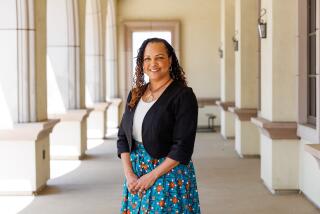Biological Reductionism in the Classroom : THE LEARNING MYSTIQUE A Critical Look at ‘Learning Disabilities’ <i> by Gerald Coles (Pantheon: $22.95; 330 pp.) </i>
- Share via
Psychiatrist Gerald Coles argues in “The Learning Mystique” that the diagnosis “learning disabled,” currently assigned to nearly 1.8 million children in our nation’s schools, is in fact a serious misdiagnosis.
By insisting that neurological deficits are the cause of learning problems, many researchers have placed the origin of those problems within the children themselves--an example, according to Coles, of “blaming the victim.” The label alone, along with research seeking to support such a diagnostic category, distracts many of us from looking for other sources of the various learning difficulties that beset these youngsters.
This insistent emphasis on biology did not arise out of cynical or mean-spirited motives, to be sure. In fact, Coles suggests a number of reasons--political, ideological, cultural, economic--why a neurological theory of Learning Disability became popular in the 1960s, and why it has remained so in spite of so much conflicting, if not downright weak, evidence for such an explanation.
The classification LD was popularized at a time when it was becoming apparent that large numbers of middle-class children were having learning problems that, at least on the surface, could not be readily explained in the same way that the learning problems of poor, minority children had been--environmentally. A new category was needed for these children, and an LD diagnosis was deemed “less pejorative than other special education categories, and it did not consider or critique any role schools, families, or other social influences might have had in creating the learning disabilities.”
The term learning disability (one that Coles eschews) has come to signify disabilities in language, math, spelling, and especially reading. Yet for all its widespread use, it is frequently acknowledged to be a very imprecise diagnostic category. That imprecision is often disguised by a specialized nomenclature that can confuse or silence laymen and critics. In reviewing the history of the organic theory of learning problems, Coles lists the various terms that have preceded LD: strephosymbolia, word amblyopia, bradylexia, script blindness, primary reading retardation, analfabetia partialis, amnesia visualis, genetic dyslexia, reading disability, learning disability. “Some of these,” Coles points out, “could have been written in plain English as simply slow reading, partial illiteracy and visual amnesia; instead, Latin and Greek mumbo jumbo lends an air of medical authority.”
But what Coles takes particular issue with is the stubbornness of theory in the face of diminishing research returns. Rather than questioning the basic premise of a neurological cause for learning problems, many researchers pursue their objective with increasingly sophisticated research designs and technologies, as though the problem may lie with method, and not theory. Coles provides a well documented overview of the range of LD research. He discusses dichotic hearing tests, EEGs, BEAM scans, CAT scans, use of drugs such as Ritalin, genetic studies and gender studies.
In examining assumptions of such research, methods employed, and interpretations of results, Coles clearly and effectively undermines researchers’ claims of solid evidence for the neurological view of LD. “Biological reductionism abounds, all but biological explanations are disregarded, causation is confused with correlation, logic is frequently contorted, circular reasoning is prevalent, statistics, numbers, and other data are manipulated to demonstrate ‘proof,’ convenient explanations are substituted for complex analysis, bias constantly skews conclusions, and at times calculated distortions appear to underly ‘findings.’ ”
Coles proposes an alternative theory of interactivity. The true causes for the learning problems faced by the majority of LD--diagnosed youngsters, he insists, are not neurological, but much more diverse and complex. They include the vicissitudes of family life, early experience, economic circumstances as they bear down on a family, teacher attitudes, school attitudes toward teachers and learning.
“Learning difficulties, and any neurological dysfunctions associated with them, developed not from within the individual but from the individual’s interaction within social relationships. Brain functioning is both a product of and contributor to the individual’s interactions, it is not a predetermined condition.” Coles encourages us to continue to seek more practical methods of helping children learn, and to take a long, hard look at the “social philosophy, political ideology, and cultural mythology associated with the social order and the maintenance of that order.”
Coles stands squarely within the tradition of idealistic reform, in the company of the likes of Kohl, Kozol and Silberman. His momentum falters somewhat as he widens his gaze to include history, ideology and the larger culture: It is a lot to embrace. Yes his argument is convincing. Certainly, looking at the wide range of influences brought to bear on children, and their learning patterns, does not promise an immediate or simplistic remedy. Such a view does increase the likelihood that we will be more faithful to the truth of our children’s (and our own) experience.






